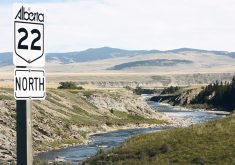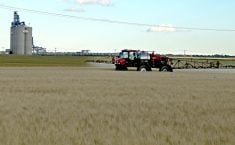WINNIPEG (Reuters) – Less snowfall than usual in dry areas of Alberta points to a severe drought continuing this year, which would make it more difficult for ranchers to feed their cattle.
Precipitation was less than 40 percent of average from Nov. 1 to Feb. 7 in a broad region of east-central Alberta into western Saskatchewan, according to Agriculture Canada’s Drought Watch website.
“The concern is you pile those (dry conditions) on top of last year’s conditions and you have no soil moisture,” said Trevor Hadwen, an agroclimate specialist with the department.
Read Also

New coal mine proposal met with old concerns
A smaller version of the previously rejected Grassy Mountain coal mine project in Crowsnest Pass is back on the table, and the Livingstone Landowners Group continues to voice concerns about the environmental risks.
“Last year they had a little bit of soil moisture going into the year, but this year they have none.”
The east-central Alberta drought zone had moderately to extremely dry precipitation conditions from August through January, according to the provincial government.
The Prairies make up Canada’s main grain-growing region, with Alberta the top cattle producer. Canada is the world’s third-largest beef exporter.
Last summer’s drought capped Alberta’s driest decade on record, stunting pasture growth and forcing ranchers to find alternatives for feeding their cattle.
The drought, along with longer-standing industry challenges such as dwindling U.S. demand for cattle, caused ranchers to thin the province’s beef cow herd to its smallest size since the 1970s.
Alberta’s beef cow herd had slipped 8.4 percent to 1.79 million head as of July 1.
The herd may have thinned enough that its numbers will stabilize this year, even if the drought continues, said Ken Ziegler, a beef specialist with Alberta Agriculture.
Some ranchers will look to sell but others may attempt to buy or rent more land to gather up what pasture is available, he added.
Ranchers should be able to buy feed barley cheaply if drought limits pasture growth, he said.
Hadwen said it’s too early to say drought is sure to continue because February and March can typically bring a lot of snow.
Environment Canada said last month that the prairie winter looks dry, but the spring and summer should be wetter than usual.
Ziegler said the weather in Alberta is especially volatile.
“The tap can come on and the tap can come off. You could have a three inch rain in May and all the problems are solved.”
Some farmers may plant cereals over canola this spring because the larger seeds might be better suited for growth in dry soil, said Ron Frost, an analyst with Agri-Trend Marketing in Calgary.
Farmers will also pay attention to which wheat and canola varieties performed well in the drought last year and may be tempted to plant legumes such as lentils and peas that did well, he added.
Much of Manitoba has also received less precipitation than average, but that’s not necessarily a bad sign, Hadwen said. The Red River Valley is prone to flooding and parts of the Interlake region were too wet to plant last year.
















